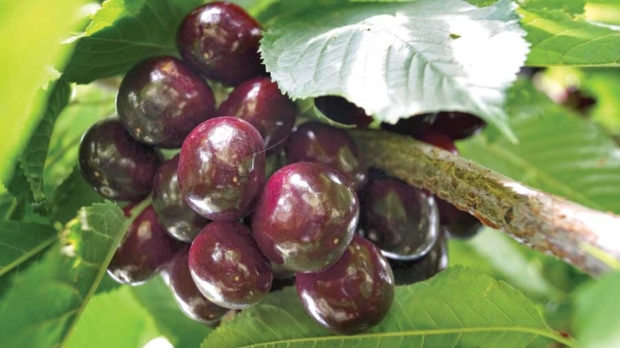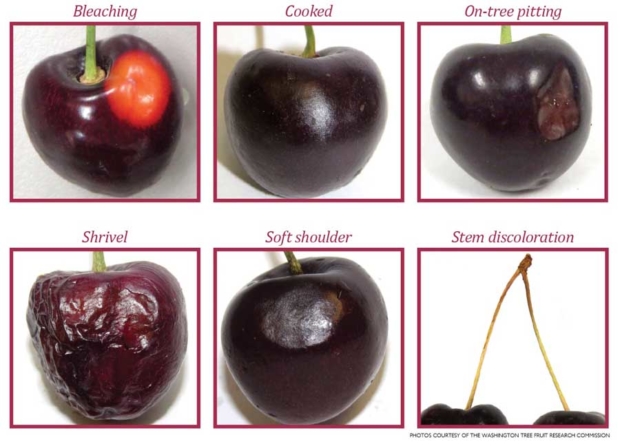
The earliest advanced selection in 2015 was the R25, ripening within three days of Chelan.(Courtesy Washington Tree Fruit Research Commission)
The 2015 season marked a rebuilding year of sorts for Washington State University’s sweet cherry breeding program, with a focus on horticultural practices in the orchard, but research continues into new varieties that will meet growers’ needs.
Established in 1949, the cherry breeding program had its first major release with the popular blush Rainier variety in 1952, and growers continue to seek new varieties that are easier to grow and extend the growing season — and, ultimately, expand growers’ spot in the marketplace.
In 2015, research focused on trellis and netting installation for early selections, standardization of irrigation systems and phenotyping protocols, and accurate plot mapping — all of which led to improvement of tree health and uniformity.
Phenotype evaluation continued in 2015, with focus on a number of selections that previously advanced to phase two and phase three trials. One that’s getting particular attention: R25, a dark red selection that ripens several days earlier than Chelan.
Trials
Phase one trials involve evaluating the initial cross; to advance to phase two, fruit must meet minimum standards for size, firmness and target market class.
Phase two selections have been planted at four sites in Washington (Pasco, Prosser and Wenatchee) and Oregon (Hood River), with phase three selections planted in Pasco and Orondo, Washington, and in Hood River.
In addition to size and firmness, selections are then compared to conventional varieties in the following areas:
—Early season blush or red cherries with cracking tolerance.
—Late season blush or red cherries, especially those with resistance to mildew.
—Selections suited to mechanical harvesting without stems.
—Midseason red cherries that are bigger and firmer than Bing.
In 2015, none of the red selections in phase two met the size and firmness standards set by the Breeding Program Advisory Committee (BPAC). Several red selections did better than Bing and Sweetheart, the control varieties, but failed to meet the target, according to Dr. Ines Hanrahan, research scientist for the Washington Tree Fruit Research Commission.
“Some of this can be explained by the less than optimal horticultural conditions the trees were grown in the previous year. We amended these problems, so next year we should have a much better look,” she said.
Three blush selections made the cut, “so we have a lot of material that is quite promising in the blush selections that is early to midseason timing, or between Early Robin and Rainier timing,” Hanrahan said.
One red selection, Roza 2 (R2), was believed to be a Chelan replacement, but researchers saw a number of problems with it in 2015.
“We had uneven maturity on the tree and a lot of pre-harvest drop. The fruit size was 11 row, so smaller than a BPAC threshold. The fruit is firm, but the maturity was one week behind Chelan,” she said. “We also noticed quite an inconsistent taste with this selection.”
R25

CLICK TO DOWNLOAD THE PDF — The R25 variety from green tip. Photos courtesy Washington Tree Fruit Research Commission. (Jared Johnson/Good Fruit Grower illustration)
The earliest advanced selection in 2015 was the R25 selection, ripening within three days of Chelan. The fruit size was also not stellar, but it’s a firm cherry.
“It’s very crunchy. It’s almost like an apple — you can hear the crunch when you bite into the cherry. I think that’s really fantastic,” Hanrahan said.
Researchers did not observe any doubles with R25, it was not sensitive to cracking and it had good taste across several color grades.
But, of course, it’s not all perfect, Hanrahan said: Researchers saw uneven color development as the fruit matured, with very blotchy fruit in various stages of maturity before color finally evened out when reaching harvest maturity.
Overall, Hanrahan said several of the red cherries that were believed to be late season selections were reclassified last year as mid-season varieties, with Bing to Lapins harvest timing, following further evaluation.
There also are more early-season blush selections in the program than thought, “and we feel that phase two contains quite a few blush selections that look promising and are early.”
Introduction of any of the selections for commercial production is still a long way off, with at least two more years of data needed to even move to phase three evaluations, Hanrahan said, and an additional five more years of preparation.
Dr. Mike Willett, manager of the Washington Tree Fruit Research Commission, said there’s still a lot more to learn about where the selections that are currently under evaluation are going to fit — or if they’re going to fit — into the current cherry production scheme. “It’s just too early to know,” he said.
Direction change
Meanwhile, the breeding program is undergoing a leadership change.
Dr. Nnadozie Oraguzie, WSU’s cherry breeder for eight years, is stepping away from that role to focus full-time on genetics research, according to a March 28 email to staff by Dr. Kimberlee Kidwell, acting dean of the WSU College of Agricultural, Human and Natural Resource Sciences.
Kidwell expressed gratitude to the Washington Tree Fruit Research Commission and the Oregon Sweet Cherry Commission for continued support of the program.
“We look forward to partnering with you to continue building a world-class cherry breeding program at WSU that serves the needs of producers throughout the Pacific Northwest,” she said.
The entire Pacific Northwest cherry industry supports continued efforts to breed new varieties and continues to put resources into maintaining the existing germplasm so that the program can be picked up whenever a new person is hired, Willett said.
This year, in addition to maintaining that germplasm, the focus will be to learn more about phenotypes of individual selections, such as maturity date, size, firmness, color and bloom date.
“The industry feels that there is a need to have improved cultivars in both the early season and the late season, and that’s the focus that the industry would like to see of any efforts going forward in the breeding program,” Willett said.
WSU has hired a research associate, Bernardita Sallato, to work with the directors of the university’s Irrigated Agriculture Research and Extension Center in Prosser and the Tree Fruit Research and Extension Center in Wenatchee to manage and advance the breeding material for the 2016 crop year. Sallato started April 1.
A search for WSU’s next cherry breeder will begin in spring 2017, Kidwell said. •
Heat damage
The record temperatures in 2015 afforded researchers the opportunity to evaluate cherry breeding selections for heat tolerance.
A number of selections showed susceptibility to the heat, with pre-harvest symptoms that included shrivel, discolored stems, on-tree pitting, soft or “cooked” shoulders and bleaching, said Dr. Ines Hanrahan, research scientist for the Washington Tree Fruit Research Commission.
Post-harvest symptoms included shoulder shrivel and a lack of luster on the cherries.
The heat also altered the maturation pattern for conventional cultivars. Sweethearts and Bings, in particular, showed delayed color development.

Examples of heat stressed cherries. (Photos courtesy of the Washington Tree Fruit Research Commission)
– by Shannon Dininny






Leave A Comment